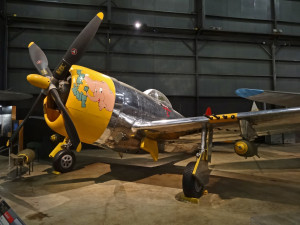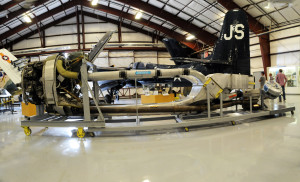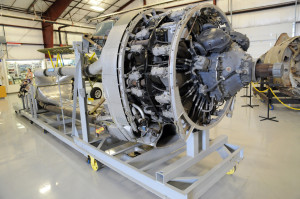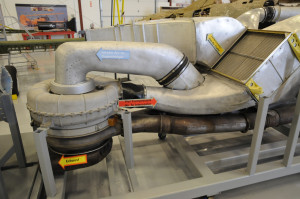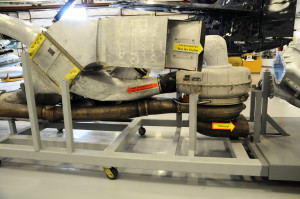Peter Lobner
The P-47 Thunderbolt, built by Republic Aviation, was a powerful WW II fighter that was capable of operating effectively at high-altitude as a long-range bomber escort or at low altitude as a fighter bomber. That tactical flexibility was enabled by its turbocharged Pratt & Whitney Double Wasp R-2800, two-row, 18-cylinder radial engine. A representative P-47D is shown in the following photo.
Basic specifications for a P-47D are listed below (Source: National Museum of the USAF):
- Engine: One Pratt & Whitney R-2800 radial rated at 2,430 hp
- Maximum speed: 433 mph
- Cruising speed: 350 mph
- Range: Approx. 1,100 miles with drop tanks
- Ceiling: 42,000 ft.
- Armament: Eight .50-cal machine guns and 2,500 lbs. of bombs or rockets
- Span: 40 ft. 9 in.
- Length: 36 ft. 2 in.
- Height: 14 ft. 8 in.
- Weight: 17,500 lbs. maximum
The basic engine installation can be seen in the following illustration of a P-47 without its engine cowling:
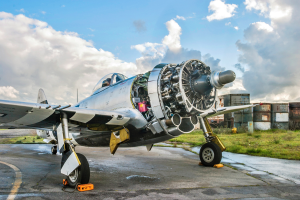 Source: https://www.flickr.com/photos/wingmanphoto/7166461822/
Source: https://www.flickr.com/photos/wingmanphoto/7166461822/
The R-2800 engine is turbocharged, with the turbocharger, intercooler, and related subsystems all located behind the pilot. There is a lot of intake ductwork needed to get ambient air routed from the main air duct intake immediately under the engine to the turbocharger and intercooler and then back to the carburetors on the engine.
- The air entering the turbocharger is compressed and, in the process, is heated. This air passes through the intercooler where it is cooled before being directed back to the engine and the carburetors for each of the 18 cylinders.
- The air entering the intercooler cools the compressed air from the turbocharger’s compressor and then is discharged through exit doors on the sides of the P-47 fuselage, aft of the pilot.
Similarly, there is a lot of exhaust system ductwork needed to collect the exhaust from 18 cylinders into tailpipes and then route it back to drive the turbine section of the turbocharger and then be discharged via the main exhaust on the bottom of the P-47 fuselage.
These basic intake air and exhaust flow paths are shown in the following diagram.
 Source: National Museum of the USAF
Source: National Museum of the USAF
While visiting the National Museum of WW II Aviation in Colorado Springs, CO, I saw the complete P-47 powertrain shown in the following photo. The engine is at the extreme left, the turbocharger is at the extreme right, and the intercooler is at the point where the carburetor air duct (top) converges in a “V” with the main air duct (bottom). The darker exhaust tailpipes flank the main air duct along the bottom of the powerplant.
From the front, the Pratt & Whitney R-2800 dominates the view in the following photo. The main air duct intake is visible under the engine. The carburetor air duct (top), and the main air duct and darker exhaust tailpipe (bottom) are visible to the left, behind the engine.
From the back of the powerplant, the turbocharger dominates the view in the following photo. As shown by the arrows, intake air enters the compressor section of the turbocharger from the top (grey arrow) and exits via the volute (red arrow), headed for the intercooler. The darker exhaust tailpipe can be seen connecting to the turbine secion of the turbocharger (below the red arrow) and exhausting under the turbocharger (yellow arrow).
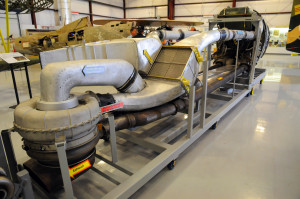 Source: Author photo
Source: Author photo
The following photo shows more clearly the connection of the exhaust tailpipes to the turbine section of the turbocharger and the exhaust point from the turbine section (beneath the P-47’s fuselage). Also shown is the intercooler, which is a heat exchanger that receives cool ambient air from the main air intake duct and warm, compressed air from the turbocharger’s compressor discharge (red arrow). After cooling the compressed air headed for the carburetors, the intercooler exhausts through rectangular ducts on the sides of the P-47 (yellow arrow).
A better view of the intercooler exhaust duct (one of two) is shown in the following photo.
So there you have it. While the P-47 looks bulky , this is largely due to the use of a big radial engine plus all of the ductwork, intercooler and turbocharger hardware packaged inside the fuselage.
